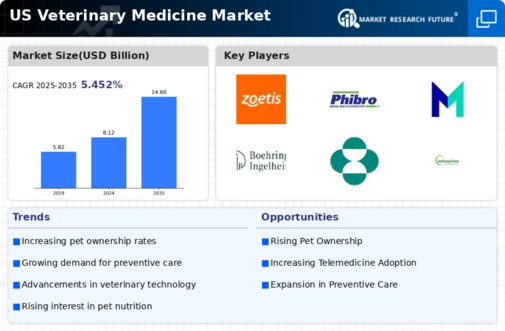The US Veterinary Medicine Market is characterized by a dynamic competitive landscape that has been shaped by a combination of innovation, regulatory factors, and evolving consumer preferences. The market is driven by the growing emphasis on animal health and welfare, alongside rising pet ownership rates. As veterinarians and pet owners increasingly recognize the importance of preventative healthcare and effective treatments, numerous companies strive to differentiate their products and services within a crowded marketplace. This has led to increased investment in research and development, facilitating the introduction of advanced pharmaceuticals, vaccines, and diagnostics.
Furthermore, the demand for integrated care solutions and practices that focus on holistic well-being plays a significant role in shaping the competitive environment. Companies actively engage in mergers and acquisitions in order to expand their product lines and strengthen their presence within the market, enhancing their competitive advantage and aligning with the overarching market trends of innovation and quality.
In the context of the US Veterinary Medicine Market, Zoetis stands out due to its unparalleled commitment to animal health, bolstered by an extensive portfolio of products that includes vaccines, diagnostics, and therapeutics tailored for both food-producing and companion animals. Recognized as a leader in the industry, Zoetis leverages its strong research and development foundation to continually introduce new and effective solutions that address the evolving needs of veterinarians and pet owners alike. The company's robust distribution network ensures widespread availability of its products, further solidifying its market position.
Zoetis’s strength lies not only in innovation but also in its ability to respond quickly to market demands, reinforcing customer loyalty through veterinarian partnerships and educational initiatives that heighten awareness around animal healthcare.
MediVet Biologics, while smaller in scale, has carved out a notable niche in the US Veterinary Medicine Market through its unique focus on regenerative medicine and biologics. The company specializes in providing advanced therapies, particularly using cutting-edge stem cell technology and platelet-rich plasma applications to treat a variety of conditions affecting pets and horses. MediVet Biologics emphasizes the importance of minimally invasive treatment options, appealing to a growing demographic that values less conventional approaches to animal healthcare. The company has built strong relationships with veterinary practitioners and academic institutions, enhancing its credibility and presence within the market.
Through strategic collaborations and an emphasis on education for veterinary professionals, MediVet Biologics has successfully positioned itself as a pioneer in the growing field of regenerative medicine, contributing to its competitive edge in a rapidly evolving sector. Additionally, the company continues to explore opportunities for mergers and acquisitions to expand its reach and improve its product offerings.



















